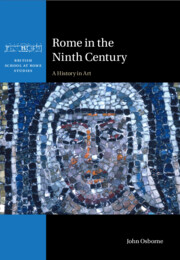Book contents
- Rome in the Ninth Century
- British School at Rome Studies
- Rome in the Ninth Century
- Copyright page
- Contents
- Figures
- Acknowledgements
- Abbreviations
- Ninth-century Popes
- 1 Introduction
- 2 Rome in 800: The Pontificate of Leo III
- 3 Paschal I, the Church of Santa Prassede and the Question of a ‘Carolingian Renovatio’ in Rome
- 4 Paschal I: Other Projects
- 5 Eugenius II, Gregory IV and Sergius II
- 6 The Gathering Storm: The Pontificate of Pope Leo IV (847–55)
- 7 Benedict III, Nicholas I and Hadrian II, and the Continuing ‘Greek’ Presence in Rome
- 8 The Last Hurrah: John VIII (872–82)
- 9 ‘Not with a Bang but a Whimper’
- Afterword
- Bibliography
- Index
2 - Rome in 800: The Pontificate of Leo III
Published online by Cambridge University Press: 10 October 2023
- Rome in the Ninth Century
- British School at Rome Studies
- Rome in the Ninth Century
- Copyright page
- Contents
- Figures
- Acknowledgements
- Abbreviations
- Ninth-century Popes
- 1 Introduction
- 2 Rome in 800: The Pontificate of Leo III
- 3 Paschal I, the Church of Santa Prassede and the Question of a ‘Carolingian Renovatio’ in Rome
- 4 Paschal I: Other Projects
- 5 Eugenius II, Gregory IV and Sergius II
- 6 The Gathering Storm: The Pontificate of Pope Leo IV (847–55)
- 7 Benedict III, Nicholas I and Hadrian II, and the Continuing ‘Greek’ Presence in Rome
- 8 The Last Hurrah: John VIII (872–82)
- 9 ‘Not with a Bang but a Whimper’
- Afterword
- Bibliography
- Index
Summary
This chapter establishes the political and cultural context for what follows through an examination of the reign of Pope Leo III (795–816) and his alliance with the Franks, notably Charlemagne, whom he crowned as Roman emperor on 25 December 800. A primary focus is the political and other messages implicit or explicit in the construction and decoration of new reception spaces at the Lateran patriarchate and Saint Peter’s, aimed at reinforcing the new role of the papacy in temporal as well as spiritual matters, and the mosaic decorations for which Leo was responsible in the churches of Santa Susanna and Santi Nereo ed Achilleo. An analysis is provided of the exceptionally detailed list of papal gifts to Roman churches, known as the ‘Donation of 807’, and the chapter concludes with an analysis of the possible sources of papal wealth necessary to make such extravagant largesse possible.
Keywords
- Type
- Chapter
- Information
- Rome in the Ninth CenturyA History in Art, pp. 10 - 50Publisher: Cambridge University PressPrint publication year: 2023

